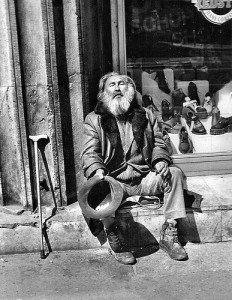Throughout her life, a dear friend of mine has endured many hardships and experienced much heartbreak. During her twenty-five years of marriage, her husband had numerous affairs, became an alcoholic, and subjected her to extreme psychological abuse, giving her no support as she struggled to raise five children. Since their separation, he has been unfaithful to their divorce settlement, often leaving her in a precarious financial situation. She now is wrestling with a number of health problems. Yet instead of becoming a bitter and defeated individual, she has come to enjoy a deep, abiding, and truly remarkable faith.
 She tells me that she used to find strength in the popular “Footprints” story in which a man dreams of his life as a walk along the beach with the Lord. Most of the time, two sets of footprints were visible in the sand- one for Jesus, and one for the man. However, during times of suffering, pain, and trial, there was only one set of footprints. The man was angry and he challenged Jesus. “Where were you when I needed you most?” he cried. Jesus replied, “I was with you all along! When you see only one set of footprints, it was then that I carried you.”
She tells me that she used to find strength in the popular “Footprints” story in which a man dreams of his life as a walk along the beach with the Lord. Most of the time, two sets of footprints were visible in the sand- one for Jesus, and one for the man. However, during times of suffering, pain, and trial, there was only one set of footprints. The man was angry and he challenged Jesus. “Where were you when I needed you most?” he cried. Jesus replied, “I was with you all along! When you see only one set of footprints, it was then that I carried you.”
These days, however, she doesn’t find much inspiration in this story. She explains that she no longer has to ask Jesus about where he was during the most painful periods in her life. She now knows, through her experience, that Jesus is always at her side. Suffering didn’t weaken her faith. Instead, it made it grow stronger.
This is also the experience of the “man born blind” in today’s gospel. Like my friend, he has endured a truly “hard knock life.” Until his encounter with Jesus, he’d spent his days as a panhandler, begging small change from passers-by. Most probably, people tossed him insults as often as they tossed him money, considering that the disciples themselves suggested out loud that he must be some sort of sinner. But then Jesus healed him, restoring his vision and giving him a new lease on life.
Ironically, however, this is when the man’s plight becomes even worse. Nobody shares his joy in his newfound sight. Instead, he’s met with suspicion, interrogation, and hostility. His own parents kept him at arm’s length. Religious leaders berate him as one “born in utter sin” and cast him out of the synagogue. Not only did this make him a pariah in the Jewish community, it also placed him in violation of Roman law, as it legally made him an atheist. So pity the poor man born blind! Instead of being allowed to celebrate his grace-filled encounter with Jesus, he’s alienated from his family, ostracized by his religion, and made a criminal in the eyes of the state. Yet, even after all of this, the “man born blind” was still able to embrace Jesus as his savior.
The story of the “man born blind” is meant to be our story as well. As St. Augustine once wrote, the man born blind stands for the whole human race. His experience teaches that our life of faith, which begins at baptism, can grow through difficult testing and suffering.
The gospel demonstrates this in a subtle way. It begins by making suggestive references to the sacrament of baptism. Consider how Jesus healed the “man born blind.” To begin with, Jesus made clay with his saliva and anointed the man’s eyes. This recalls two things. First, the anointing intentionally calls to mind the anointing with oil in the baptism ritual. Second, the clay expresses our belief that in baptism one is made a “new creation,” just as the first human being was created from clay in the Genesis story.
Next, Jesus instructs the blind man to wash in the “Pool of Siloam,” which, we’re specifically told, means “Sent.” These too are baptismal references. Baptism washes away our sin in a pool of water, and it unites us with Jesus, the one sent by the Father. Finally, having followed Jesus’ instructions, the man was able to see Jesus, who had just identified himself as the “light of the world,” just as in baptism we’re “enlightened” to “see” Jesus with eyes of faith.
This healing event, however, was only the beginning of the man’s journey of faith. His faith came to maturity only through his experience of testing and suffering. When his back was against the wall, he found no help or comfort from his family, the government, or his community of faith. He had no one else to turn to but Jesus! And even that took a leap of faith, because Jesus was seemingly absent throughout his ordeal. It was only when the man had hit “rock bottom” that Jesus re-appeared in person.
But maybe that’s precisely the point. It takes great faith to trust in Jesus when he doesn’t seem to be there. But that’s what the “man born blind” did. He trusted, and his faith grew. We can see this in the progressively more insightful terms he used in reference to Jesus. For instance, when first asked as to how his eyes were opened, he explained that he was healed by the “man called Jesus.” Later, when challenged again, he called Jesus a “prophet.” When pressed he even further, he asserted that Jesus was “from God.” Ultimately, after having been expelled from the  synagogue, he fell down at Jesus’ feet and worshipped him as Lord.
synagogue, he fell down at Jesus’ feet and worshipped him as Lord.
It’s true that, as the old proverb goes, “Into every life a little rain must fall.” For some people, this rain is just a sprinkle; for others, it’s a downpour. Yet the story of the “man born blind” offers us hope that this inevitable rain, instead of dampening our faith, may help it blossom and flourish.
Readings for today’s Mass: http://www.usccb.org/nab/040311.shtml
Photo credits (top to bottom): The Welsh Poppy, runran, and AlmazUK via Creative Commons

Great post that explains the reading for today! I really enjoyed reading this!!